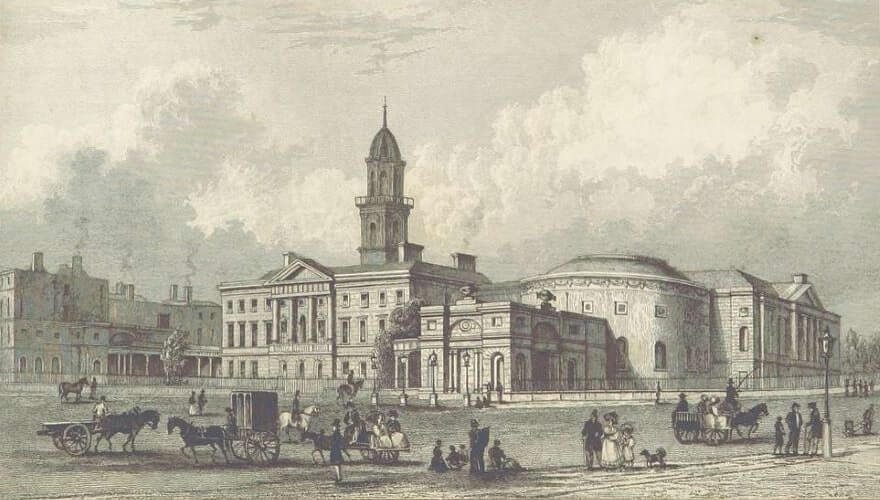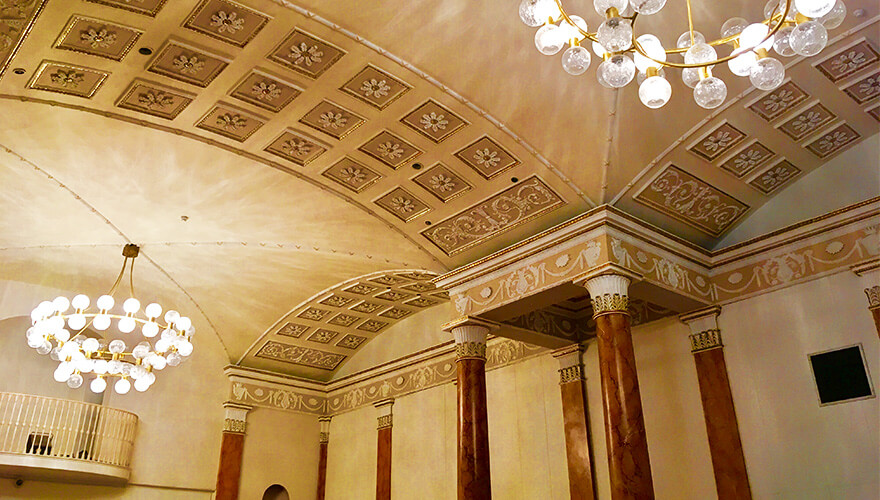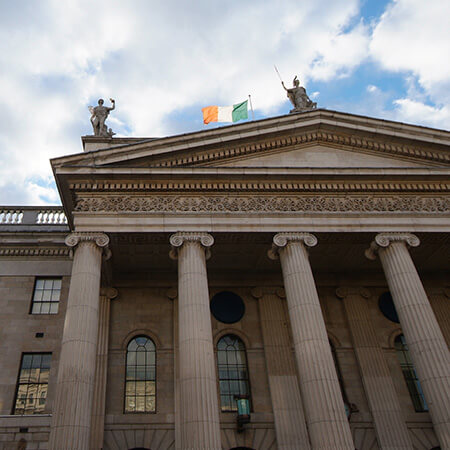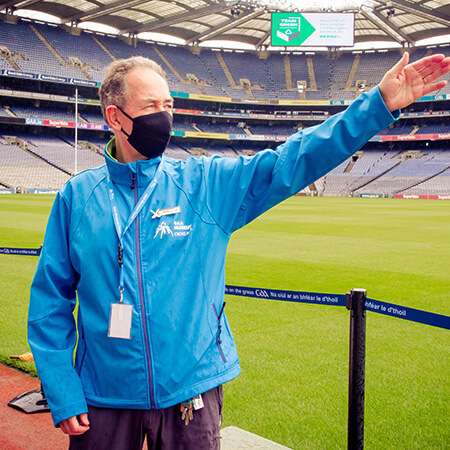With its rounded name and huge dome centre – befitting of a maternity hospital – The Rotunda sits in the centre of Dublin’s north inner city, closing off the top of O’Connell Street. An end, containing so many beginnings.
Surrounded by shops, theatres and the Garden of Remembrance, The Rotunda Hospital has long been at the heart of Dublin’s history. Throughout famines, protests, pandemics and revolution, it has quietly continued on with the ordinary business of life.
The Rotunda Hospital’s history and origins
Founded in 1745 by Bartholomew Mosse, The Rotunda is the oldest continuously-running maternity hospital in the world.
9,000 babies are born here every year, while all about them the cogs of the city whirr and roll. The new Luas line passes the doors of the hospital that were once attended by horse-drawn ambulances.
Mosse’s ambition to build a dedicated maternity hospital in Dublin had both public and private motivations. He wished to provide medical care and shelter to the penniless mothers of Dublin. This came as a result of encountering unspeakable conditions in the course of his practice – particularly after the 1739 famine.

Lying-in-hospital & Rotunda by W.H. Barton, 1837
Few people in Ireland at the time had any midwifery training. Fellows of the Royal College of Physicians were even penalised if they practiced. However, Mosse sought to change all that.
He also had heart-wrenching reasons of his own for such an ambitious project. He had lost his first wife and their newborn son after complications in labour.
After this tragedy, Mosse left Ireland to serve as a doctor with the British Army. While away, he received training at La Charité – a ward of Hotel-Dieu in Paris dedicated to midwifery.
Upon his return, he received a midwife’s licence and embarked on his plan, aided greatly by his second marriage to a wealthy heiress.
Grand plans for healthcare and fundraising
The extensive Rotunda building we know and love today comprises two separate complexes. The three-storey hospital itself and the rounded reception rooms for which the hospital is named.
The original site of Mosse’s hospital, however, was on George’s Lane in a small theatre called The New Booth. After it was shut down in scandalous circumstances, Mosse purchased it.
This first ‘lying-in’ hospital of its kind in the world. It had only ten beds, but in its first year 190 babies were born, and just one mother died. The hospital could not meet demand, and it was clear that a larger site was needed. And Mosse’s plans were anything but modest.

Opulent ceiling decoration in the Pillar Room.
These days, the only remaining patch of green near The Rotunda is the Garden of Remembrance, but that site was once where the bustling city gave way to sprawling countryside. Mosse had his eye on four acres there, described at the time as “a piece of waste ground, with a pool in the hollow, and a few cabins on the slopes”.
The Rotunda’s architecture
Mosse’s friend, architect Richard Cassels, who also designed Leinster House, Carton House and Russborough House, was brought on board and fundraising ambitions were very much on both of their minds.

From The Book of The Rotunda Hospital via Wellcome Library, London
The hospital would be surrounded by pleasure gardens inspired by London’s Vauxhall Gardens. A striking country house façade with a baroque copper dome would also be built to appeal to the elite, while the construction of concert halls would facilitate fundraising.
In the hospital itself, small wards were built to avoid the epidemics that thrived in larger ones.
Then there was the small matter of the hospital chapel. Mosse realised this would need to be particularly opulent if he was to lure the wealthy Protestants of the city to worship there.

Venetian window in The Rotunda chapel.
So he commissioned the famous stucco sculptor, Bartholomew Cramillion, to adorn the ceiling and altar with extravagant plasterwork.
It depicts saints and cherubs, all themed around the biblical psalm: “And now abideth faith, hope, charity, these three; but the greatest of these is charity.”
The privileged classes flocked to the rococo style chapel and filled the coffers of the hospital.
Today, the chapel still functions and is non-denominational. However, it’s not easily accessible, as it’s securely nestled amongst the babies in the post-natal care unit.
Though the hospital has been extended many times, the chapel remains the building’s most prominent architectural feature. From outside, the window which lights the chapel can be seen directly over The Rotunda’s front door.
The banquets and concerts that took place in the social rooms continued to support the hospital into the 20th century when its stone-faced façade oversaw some of O’Connell Street’s more riotous scenes.
The Rotunda during the Easter Rising
Located less than 500 metres away from the GPO, which was the headquarters of the uprising’s leaders, The Rotunda Hospital was caught up in the action.
During the Easter Rising, through battles and barricades, Dublin women made their way up Moore Street and Capel Street on foot to reach the sanctity of the hospital. Neither social standing nor religion mattered here – a rare attitude at the time.

O’Connell Street after the Easter Rising
Many devoted nationalists had worked inside the hospital and aided the Republican movement – Dr. Kathleen Lynn and Bridget Lyons Thornton amongst them.
During the Rising, the hospital was occupied by British military. However, staff were ordered to carry on working.
Mary McDonald, latterly a prominent figure in the Irish Countrywomen’s Association, was a midwife in The Rotunda at the time. “We saw snipers at work from the top of the houses of Parnell Square. We saw all the prisoners collected into the lawn in front of the hospital and marched away to prison,” she wrote.
The assassination of the RIC’s Captain Percival Lea-Wilson was said to be ordered by Michael Collins specifically because of his abuse of republican prisoners held in The Rotunda gardens after the 1916 surrender.
Inside the hospital was not without its own sadness. The infant mortality rate in 1916 was 160 per 1,000 births compared to today’s three per 1,000 births.

A group of students in 1911, The Book of The Rotunda Hospital via Wellcome Library, London
Mosse’s long-lasting legacy
Some of The Rotunda’s finer social rooms are no longer part of the hospital. The Rotunda Assembly Hall is now occupied by the Ambassador Theatre, and the Supper Rooms are part of The Gate Theatre. But a bust of Mosse continues to take pride of place in the hospital’s lobby.
Many great Masters were to follow him, each bringing their own advancements. In 1833, Evory Kennedy was the first obstetrician to recognise the importance of monitoring fetal heart rate. Then, in 1889, Arthur Macan supervised the first caesarean there.
Sara E. Hampson, one of the original Nightingale nurses, was the First Lady Superintendent of the hospital in 1891 and she oversaw the development of a separate nurses’ quarters. Her portrait still adorns the wall of the hospital.
The hospital itself continues to be recognised as one of the pioneer teaching hospitals of its kind in the world today.
The next time you stroll by The Rotunda, check out these other gems in Dublin’s north inner city.



